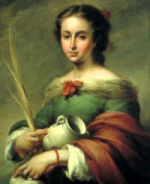The MOST Theological Collection: Our Lady In Doctrine and Devotion
"XVIII. Consortium"
We already saw that Pius XII said she is "always sharing His lot." Vatican II brings this truth out brilliantly, in great detail. We are going to read a mosaic, as it were, of texts some of which we have already seen, assembled from all over chapter 8 of LG. We suggest as you read these, to try to find the common thread running through all of them. Of course, at the end, we will explain what that is.
"The Blessed Virgin, planned for from eternity as the Mother of God along with the incarnation of the divine Word, was the loving Mother of the Redeemer on this earth, His generous associate, more than others, and the humble servant of the Lord... . She is already prophetically foreshadowed in the promise given to our first parents of victory over the serpent... similarly, she is Virgin who is to conceive and bear a Son... . The Father of Mercies willed that the Incarnation should be preceded by her acceptance... so that just as a woman contributed to death, so also a woman should contribute to life... . So Mary, consenting to the divine word, became the Mother of Jesus, and embracing the saving will of God with full heart, held back by no sin, totally dedicated herself as the handmaid of the Lord to the person and work of her Son, under Him and with Him, by grace of almighty God, serving the mystery of redemption... . the Fathers rightly consider Mary ... as cooperating with free faith and obedience for human salvation. For she, as St. Irenaeus said 'by obeying, became a cause of salvation for herself and for the whole human race. Hence not a few ancient Fathers in their preaching gladly assert with him: "the knot of the disobedience of Eve was loosed through the obedience of Mary... ." this union of the Mother with the Son in the work of salvation is made manifest from the time of His virginal conception to His death. It is shown first of all when Mary, arising in haste to go to visit Elizabeth, is greeted by her as blessed because of her faith... . This union is manifest also at the birth of Our Lord, who did not diminish His Mother's virginal, integrity, but sanctified it... . [and] when the Mother of God joyfully showed her firstborn Son to the Shepherds and the Magi... . In the public life of Jesus, Mary makes significant appearances... . she brought about by her intercession the beginning of the miracles of Jesus. In the course of her Son's preaching she received the words whereby He declared blessed those who heard and kept the word of God, as she was faithfully doing... . she persevered in her union with her Son even to the Cross, where she stood, in keeping with the divine plan, uniting herself with a motherly heart to His sacrifice, and lovingly consenting... . In suffering with Him as He died on the Cross, she cooperated in the work of the Savior in an altogether singular way, by obedience, faith, hope and burning love, to restore supernatural life to souls. Hence she is our Mother in the order of grace... . We see the Apostles in prayer with the women and Mary the Mother of Jesus... and Mary by her prayers imploring the gift of the Spirit... . Finally the Immaculate Virgin... was taken up body and soul into heavenly glory, and exalted by the Lord as Queen of the Universe, that she might be the more fully conformed to her Son, the Lord of Lords and conqueror of sin and death."
What is the common thread running through these texts? We see that although the Father did not need to go so far, yet as a matter of fact, the position He has freely chosen to give her in all of His approach to us is simply all-pervading. She is everywhere.
Obviously, if we wish to imitate His ways most fully, that would mean we would give her a similarly all-pervading place in our response to Him. Surely it would be flying in the face of the Father's plan to have no devotion at all to her. He has put here everywhere; such a one would will to put her nowhere.
We said if to stress the fact that what is objectively the best is not always obligatory for each one. In particular, there is a variety of spiritual attractions. Not all are led by the same spiritual paths. Yes, the basic principles of the spiritual life are the same for everyone. But there is a secondary tier, as it were, in which there is room for great diversity. For example, St. Francis de Sales was a highly refined gentleman. But St. Benedict Joseph Labre lived much like a tramp in the ruins of Rome, spending his days in the churches. There is even an anecdote that if one of his body lice tried to crawl out of his sleeve, he would push it back again, for mortification. Again, St. Francis of Assisi, if we can accept the story - there are many legends about him - was reluctant to let his brothers have even a few books. But St. Thomas Aquinas was the perfectly bookish man.
If, however, a person would choose to imitate the ways of the Father in this matter, that would be the same as living out a complete Marian consecration. We shall have more to say about consecration later on.
We can see, that Vatican II built a splendid theological basis for a full Marian consecration.






